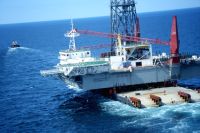|
|
||||||||||||
|
|
|
Cianbro Corporation Completes Construction of Two Deep
Sea Oil Exploration Vessels
A prominent feature of the Portland skyline disappeared as the deep sea oil exploration platfrom, Pride of Portland, slowly propelled itself through the ship channel into the foggy Atlantic. Her predecessor, the Pride of Rio de Janeiro left earlier and in now in that city awaiting an assignment to explore for undersea oil deposits. The story of how the two rigs arrived in Portland began in the late nineties when Maine based Cianbro Corp. President and CEO, Pete Vigue, searched Gulf of Mexico shipyards for new business opportunities. Bankruptcy of a company building a pair of semi-submersible oil exploration rigs presented a likely prospect.
Vigue, a Maine Maritime Academy graduate, found the two rigs partly constructed in Pascagoula, Miss. and Orange, Texas shipyards. The $340 million rigs are designed to navigate independently to a likely site. Multidirectional propulsion units governed by satellite navigational equipment keep them precisely pinpointed as a test well is drilled. When completed each rigs towers 285 feet above the water and displaces 12,000 tons.
While exploring for oil, a crew of 115 will live and work in the deck box . A pilot house atop the deck box makes it plain that these unlikely looking vessels are, indeed, fully operational ocean going ships. In late 2003 both rigs will be delivered to Petrodrill and leased out to companies drilling exploratory wells off the Brazilian coast.
When Cianbro took over, each massive deck box and its supporting pontoon assembly were in separate pieces. Cianbro won the contract to place each deck box atop its pontoon and then complete work to make the units operational. The first problem was moving the entire operation from Mississippi to Maine. The pontoons were the easy part. Reinforced by beams and braces, each was taken in tow by a tug for the journey up the East Coast.
Sealifting the deck boxes was more of a challenge. Each box had to be skidded down to the water's edge and precisely positioned aboard a barge. First the spongy shoreline was stabilized with a carpet of heavy timbers. Slowly the deck box was then inched along tracks laid on the timber bed to the deck of the waiting barge.
With 40 feet of overhang on each side of the barge, establishing a correct center of gravity was crucial. A couple of millimeters of error could compromise the mission's safety. In both cases all went well and the 12-day voyages to Maine were completed.
In Portland Harbor each deck box was jacked high above its transporting barge's deck level and supported by four pylons. The extra headroom allowed the pontoon assembly to ease under the box where the two were fastened together.
Next the pontoon assembly was nudged by tugs to straddle the barge with the top of each of its massive struts positioned under the deck box. Once the two are joined the whole rig was ballasted up and the barge was towed away. Portland Docking Pilot, Bill Gribbon, made it look easy, but lining up bolt holes for two parts of a 12,000-ton structure did not leave much room for error.
For the past couple of years, 800 workers have swarmed over the two rigs installing miles of wiring and piping. Unless Vigue turns up another job, a major component of the Portland waterfront panorama will disappear.
Photos: Cianbro Corp.
|








